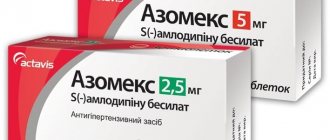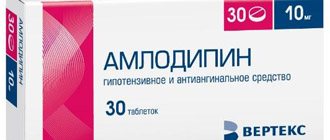Amlodipine Borimed
PHARMACODYNAMIC INTERACTIONS
Other antihypertensive and antianginal drugs
Amlodipine can be safely used for the treatment of hypertension together with thiazide diuretics, beta-blockers or ACE inhibitors.
In patients with stable angina, amlodipine can be used in combination with other antianginal agents, for example, long-acting or short-acting nitrates, beta-blockers.
It is possible to enhance the antianginal and antihypertensive effects of BMCC when used together with thiazide and loop diuretics, ACE inhibitors, beta-blockers and nitrates.
Ethanol, barbiturates, antipsychotics, antidepressants, narcotic analgesics, general anesthesia
It is possible to enhance the antihypertensive effect of dihydropyridine derivatives and increase the risk of orthostatic hypotension.
Other drugs that can lower blood pressure
It can be expected that some drugs (for example, baclofen and amifostine), due to their pharmacological properties, will enhance the antihypertensive effect of amlodipine. Monitoring of blood pressure and renal function is necessary, as well as dose adjustment of amlodipine if necessary.
Corticosteroids (mineral and glucocorticosteroids), tetracosactide
Reduced antihypertensive effect of amlodipine (due to fluid and sodium ion retention as a result of the action of corticosteroids).
Calcium preparations
Calcium supplements can reduce the effect of BMCC.
Dantrolene (with intravenous administration)
In animal experiments, cases of fatal ventricular fibrillation and cardiovascular failure associated with hyperkalemia were observed after the administration of verapamil and dantrolene (intravenously). Given the risk of developing hyperkalemia, the simultaneous use of BMCC (including amlodipine) and dantrolene should be avoided in patients with malignant hyperthermia.
PHARMACOKINETIC INTERACTIONS
The influence of other drugs on the pharmacokinetics of amlodipine
CYP3A4 isoenzyme inhibitors
With the simultaneous use of diltiazem at a dose of 180 mg and amlodipine at a dose of 5 mg in elderly patients (69 to 87 years) with arterial hypertension, an increase in systemic exposure of amlodipine by 57% was observed. Concomitant use of amlodipine and erythromycin in healthy volunteers (18 to 43 years of age) does not lead to significant changes in amlodipine exposure (increase in the area of the concentration-time curve (AUC) by 22%). The clinical significance of these effects is unclear.
Ritonavir (a potent inhibitor of the CYP3A4 isoenzyme) increases plasma concentrations of BMCC, including amlodipine.
It is possible that potent inhibitors of the CYP3A4 isoenzyme (for example, ketoconazole, itraconazole, ritonavir) may increase the plasma concentration of amlodipine to a greater extent than diltiazem. Amlodipine should be used with caution simultaneously with inhibitors of the CYP3A4 isoenzyme (especially in elderly patients).
Clarithromycin
Clarithromycin is an inhibitor of the CYP3A4 isoenzyme. Patients taking clarithromycin and amplodipine at the same time have an increased risk of low blood pressure. Patients taking this combination are advised to be under close medical supervision.
Inducers of the CYP3A4 isoenzyme
There are no data on the effect of inducers of the CYP3A4 isoenzyme on the pharmacokinetics of amlodipine. Amlodipine should be used with caution simultaneously with inducers of the CYP3A4 isoenzyme (phenobarbital, phenytoin, carbamazepine, primidone, rifampicin, St. John's wort preparations); carefully monitor blood pressure during their simultaneous use (the antihypertensive effect of amlodipine may be weakened).
Grapefruit juice
A simultaneous single dose of 240 mg of grapefruit juice and 10 mg of amlodipine orally is not accompanied by a significant change in the pharmacokinetics of amlodipine. However, it is not recommended to use grapefruit juice and amlodipine simultaneously, since genetic polymorphism of the cytochrome P450 isoenzyme may increase the bioavailability of amlodipine and, as a result, enhance its antihypertensive effect.
Aluminum- or magnesium-containing antacids
When taken together once a day, they do not have a significant effect on the pharmacokinetics of amlodipine.
Sildenafil
A single dose of 100 mg of sildenafil in patients with essential hypertension does not affect the pharmacokinetic parameters of amlodipine.
Cimetidine
Cimetidine does not affect the pharmacokinetics of amlodipine.
Effect of amlodipine on the pharmacokinetics of other drugs
Simvastatin
Simultaneous repeated use of amlodipine at a dose of 10 mg and simvastatin at a dose of 80 mg leads to an increase in simvastatin exposure by 77%. In such cases, the dose of simvastatin should be limited to 20 mg.
Atorvastatin
Repeated co-administration of amlodipine at a dose of 10 mg and atorvastatin at a dose of 80 mg is not accompanied by significant changes in the pharmacokinetic parameters of AUC (increase by an average of 18%) Cmax and TCmax of atorvastatin.
Cyclosporine
Studies of the simultaneous use of amlodipine and cyclosporine in healthy volunteers and all groups of patients, with the exception of patients after kidney transplantation, have not been conducted. Various studies of the interaction of amlodipine with cyclosporine in patients after kidney transplantation show that the use of this combination may not lead to any effect or increase the trough concentration of cyclosporine to varying degrees, up to 40%. These data should be taken into account and cyclosporine concentrations should be monitored in this group of patients when cyclosporine and amlodipine are co-administered.
Tacrolimus
When used simultaneously with amlodipine, there is a risk of increasing the concentration of tacrolimus in the blood plasma. To avoid the toxicity of this drug when used concomitantly with amlodipine, tacrolimus plasma concentrations should be monitored and the tacrolimus dose adjusted if necessary.
mTOR inhibitors (mammalion Target of Rapamycin - target of rapamycin in mammalian cells)
mTOR inhibitors (eg, temsirolimus, sirolimus, everolimus) are CYP3A4 substrates. Because amlodipine is a weak CYP3A4 inhibitor, concomitant use may increase exposure to mTOR inhibitors.
Ethanol
Amlodipine with single and repeated use in a dose of 10 mg does not affect the pharmacokinetics of ethanol.
Lithium preparations
When BMCC is used together with lithium preparations (no data are available for amlodipine), it is possible that their neurotoxicity (nausea, vomiting, diarrhea, ataxia, tremor, tinnitus) may increase.
Digoxin
Amlodipine does not affect serum digoxin concentrations or its renal clearance in healthy volunteers. In in vitro studies, amlodipine did not affect the binding of digoxin to plasma proteins.
Warfarin
Amlodipine does not have a significant effect on the effect of warfarin (prothrombin time). In in vitro studies, amlodipine did not affect the binding of warfarin to plasma proteins.
Phenytoin
In in vitro studies, amlodipine did not affect the plasma protein binding of phenytoin.
OTHER INTERACTIONS
Amlodipine can be safely used concomitantly with antibiotics and oral hypoglycemic agents.
Unlike other BMCCs, no clinically significant interaction was found between amlodipine when used in combination with non-steroidal anti-inflammatory drugs (NSAIDs), including indomethacin. In in vitro studies, amlodipine did not affect the binding of indomethacin to plasma proteins.
Although negative inotropic effects have generally not been observed in amlodipine studies, some CBMCs may enhance the negative inotropic effects of antiarrhythmic drugs that prolong the QT interval (eg, amiodarone and quinidine).
Citramon-Borimed tablets No. 6x1
Name
Citramon-Borimed tablet in container pack No. 6x1
Description
Tablets are light brown in color with white inclusions, with the smell of cocoa, with a flat surface, scored and chamfered.
Main active ingredient
Acetylsalicylic acid+caffeine+paracetamol
Release form
pills
Pharmacological properties
Pharmacodynamics
Acetylsalicylic acid has analgesic, antipyretic and anti-inflammatory properties, primarily due to inhibition of the biosynthesis of prostaglandins and thromboxanes from arachidonic acid through irreversible acetylation of the enzyme cyclooxygenase (COX). Paracetamol has analgesic and antipyretic properties, but unlike acetylsalicylic acid, it does not inhibit platelet aggregation. The addition of caffeine increases the antinociceptive effects of acetylsalicylic acid and paracetamol.
Pharmacokinetics
Acetylsalicylic acid After oral administration, absorption usually occurs quickly and completely. Acetylsalicylic acid is largely hydrolyzed to salicylates in the gastrointestinal tract, liver and blood, and then further metabolized, primarily in the liver. Paracetamol Paracetamol is easily absorbed from the gastrointestinal tract with maximum concentrations in plasma. This occurs within 30 minutes to 2 hours after ingestion. Paracetamol is metabolized in the liver and excreted in the urine mainly in the form of glucuronide and sulfate conjugates. Less than 5% of paracetamol is excreted unchanged from the body. The half-life ranges from 1 to 4 hours. Plasma protein binding is negligible at normal therapeutic concentrations but increases with increasing concentrations. The hydroxylated metabolite, which is usually formed in very small quantities in the liver by mixed-function oxidases and which is usually detoxified by conjugation with hepatic glutathione, can accumulate as a result of paracetamol overdose and cause liver damage. Caffeine Caffeine is completely and quickly absorbed after oral administration in maximum concentrations. This occurs within 5-90 minutes after taking the dose on an empty stomach. There is no evidence of first pass metabolism. In adults, there is marked individual variability in the rate of excretion. The mean plasma half-life is 4.9 hours, with a range of 1.9-12.2 hours. Caffeine is distributed throughout all body fluids. The average binding of caffeine to plasma proteins is 35%. Caffeine is almost completely metabolized by oxidation, demethylation and acetylation, and is excreted in the urine. The main metabolites are 1-methylxanthine, 7-methylxanthine, 1,7-dimethylxanthine (paraxanthine). Minor metabolites include 1-methyluric acid and 5-acetylamino-6-formylamino-3-methyluracil (AMFU). Combination In a combination of three active ingredients, the amount of each substance is low. Therefore, there is no suppression of elimination processes with subsequent risks of increased half-life and toxicity. Pharmacokinetic data for the fixed combination of acetylsalicylic acid, paracetamol and caffeine correspond to the pharmacokinetic profiles established either for each substance separately or for the combination of each analgesic component with caffeine. Critical drug interactions between acetylsalicylic acid, paracetamol and caffeine or any increased risks of interaction with other drugs when used together are not known. No interactions were observed between the three active substances.
Indications for use
Citramon-Borimed is indicated for adults for the treatment of acute headaches.
Directions for use and doses
Adults The usual recommended dose is 1 tablet; You can take an additional tablet, the interval between doses should be from 4 to 6 hours. In case of very severe pain, if necessary, you can take 2 more tablets, the interval between doses should be from 4 to 6 hours. Citramon-Borimed is intended for periodic use; for headaches, it can be taken for up to 4 days. For headaches, medication intake should be limited - no more than 6 tablets per 24 hours. The medicine should not be used for a longer period of time or at a higher dosage without first consulting your doctor. Each dose should be taken with a whole glass of water. Children and adolescents (under 18 years of age) The safety and effectiveness of Citramon-Borimed in children and adolescents has not been assessed. Therefore, the use of the drug in children and adolescents is not recommended (see section “Precautions”). Elderly Patients Based on general medical recommendations, caution should be exercised when administering the drug to elderly patients, especially elderly patients with low body weight. Hepatic and renal failure The effect of hepatic or renal failure on the pharmacokinetics of Citramon-Borimed has not been assessed. Due to the mechanism of action of acetylsalicylic acid (aspirin) and paracetamol, renal or liver failure may increase. Thus, Citramon-Borimed is contraindicated in patients with severe hepatic or renal insufficiency (see section “Contraindications”). Use with caution in patients with mild or moderate hepatic or renal impairment.
Use during pregnancy and lactation
Pregnancy There is no information on the use of Citramon-Borimed in pregnant women. Animal studies have not been conducted on the combination of acetylsalicylic acid (aspirin), paracetamol and caffeine. Acetylsalicylic acid Due to the presence of acetylsalicylic acid in the drug, its use is contraindicated in the third trimester of pregnancy (see section “Contraindications”), caution should be exercised when using the drug in the first two trimesters of pregnancy. Inhibition of prostaglandin synthesis may adversely affect pregnancy and/or embryonic/fetal development. Evidence from epidemiological studies suggests an increased risk of miscarriage, heart failure, and gastroschisis following the use of prostaglandin synthesis inhibitors in early pregnancy. The risk is believed to increase with increasing dose and duration of treatment. Administration of prostaglandin synthesis inhibitors in animals has been shown to increase preimplantation losses, postimplantation losses, and embryo/fetal death. In addition, an increase in the number of cases of the development of various disorders, including cardiovascular diseases, was recorded in animals that were administered inhibitors of prostaglandin synthesis during the organogenetic period. During the first and second trimesters of pregnancy, acetylsalicylic acid (aspirin) should not be prescribed unless there is a clear need for it. If acetylsalicylic acid (aspirin) is used by a woman trying to become pregnant or during the first and second trimesters of pregnancy, the dose should be as low as possible and the duration of treatment as short as possible. During the third trimester of pregnancy, all prostaglandin synthesis inhibitors may have the following effects: On the fetus:
- cardiopulmonary toxicity (with premature closure of the ductus arteriosus and pulmonary hypertension);
- renal dysfunction, which may progress to renal failure with oligohydroamniosis;
For mother and newborn:
- at the end of pregnancy - possible prolongation of bleeding time, antiaggregation effect, which can occur even when taking very low doses;
- inhibition of uterine contractions, leading to delayed or prolonged labor.
Therefore, acetylsalicylic acid is contraindicated during the third trimester of pregnancy. Paracetamol Epidemiological studies indicate that paracetamol can be used in therapeutic doses during pregnancy. However, it should only be used after a careful risk-benefit assessment. Caffeine Pregnant women are advised to limit their caffeine intake to a minimum as available evidence on the effects of caffeine on the fetus suggests a potential risk. Breastfeeding Salicylates, paracetamol and caffeine are excreted in breast milk. Caffeine may affect a nursing baby's behavior (excitement, poor sleep). Salicylates may also have a potentially harmful effect on platelet function in the infant (minor bleeding may be caused), although no cases have been reported. In addition, the use of acetylsalicylic acid may potentially affect the development of Reye's syndrome in infants. Therefore, Citramon-Borimed is not recommended during breastfeeding. Fertility Acetylsalicylic acid There is some evidence that drugs that inhibit cyclooxygenase/prostaglandin synthesis may cause reproductive impairment in women due to effects on ovulation. This effect is reversible when treatment is stopped.
Precautionary measures
Are common:
- Citramon-Borimed should not be taken together with medications containing acetylsalicylic acid or paracetamol.
- Patients who experience vomiting more than 20% of their migraines or require bed rest in more than 50% of their migraines should not use Citramon-Borimed.
- If the patient’s migraine does not subside after taking the first two tablets of Citramon-Borimed, the patient should seek help from a doctor.
- Long-term use of any type of pain reliever for headaches may make the condition worse. If such a situation occurs or is expected, medical advice should be sought and treatment should be discontinued. The diagnosis of medication overuse headache should be considered in patients with chronic headaches (15 days or more per month) who have been overusing headache medications for more than 3 months. Therefore, Citramon-Borimed cannot be used for more than 10 days a month for more than 3 months.
- Caution should be exercised in patients at risk of dehydration (eg, due to illness, diarrhea, before or after major surgery).
- Citramon-Borimed may mask the signs and symptoms of infection due to its pharmacodynamic properties.
Due to the presence of acetylsalicylic acid:
- Citramon-Borimed should be used with caution in patients suffering from gout, as well as in patients with impaired renal or liver function, dehydration, uncontrolled hypertension and diabetes mellitus.
- Citramon-Borimed should be used with caution in patients with severe glucose-6-phosphate dehydrogenase (G6PD) deficiency, since acetylsalicylic acid can cause hemolysis or hemolytic anemia. Factors that may increase the risk of hemolysis include, for example, high doses, fever or acute infections.
- Citramon-Borimed may lead to an increased risk of bleeding during and after surgery (including minor operations such as tooth extraction) due to the inhibitory effect of acetylsalicylic acid on platelet aggregation, which persists for many days after administration.
- Citramon-Borimed should not be taken together with anticoagulants or other drugs that inhibit platelet aggregation, without medical supervision (see section “Interaction with other drugs”). The condition of patients with impaired hemostasis should be carefully monitored. Caution should be exercised in case of metrorrhagia or menorrhagia.
- Taking Citramon-Borimed should be stopped immediately if gastric bleeding or gastrointestinal (GIT) ulceration occurs in patients receiving this drug. Gastrointestinal bleeding, ulceration, or perforation, which can be fatal, have been reported with all NSAIDs. They may occur at any time during treatment with or without symptoms, or if there is a history of serious gastrointestinal disease. They tend to have more serious consequences in older patients. The risk of gastrointestinal bleeding may be increased by alcohol, corticosteroids and NSAIDs (see section "Interaction with other drugs").
- Citramon-Borimed may cause bronchospasm and exacerbation of asthma (so-called analgesic intolerance) or other hypersensitivity reactions. Risk factors include asthma, seasonal allergic rhinitis, nasal polyps, chronic obstructive pulmonary disease, or chronic respiratory tract infection (especially if associated with allergic rhinitis-like symptoms). This also applies to patients who have allergic reactions (eg skin reactions, itching, urticaria) to other substances. For such patients, special precautions (emergency preparedness) are recommended.
- Citramon-Borimed should not be prescribed to children and adolescents under the age of 18 unless specifically indicated, since there is a connection between acetylsalicylic acid and Reye's syndrome. Reye's syndrome is a very rare disease that affects the brain and liver and can be fatal.
- Acetylsalicylic acid may interfere with thyroid function tests due to spuriously low concentrations of levothyroxine (T4) or triiodothyronine (T3) (see Interactions with Other Drugs section).
Due to the presence of paracetamol:
- Citramon-Borimed should be prescribed with caution to patients with impaired renal or liver function, or alcohol dependence.
- The risk of paracetamol toxicity may be increased in patients taking other potentially hepatotoxic drugs or drugs that induce liver microsomal enzymes (eg, rifampicin, isoniazid, chloramphenicol, hypnotics and antiepileptic drugs including phenobarbital, phenytoin and carbamazepine). Patients with a history of alcohol abuse are at particular risk of liver damage (see section "Interactions with other drugs").
- Patients should be warned not to take other medicinal products containing paracetamol at the same time due to the risk of serious liver damage in case of overdose (see Overdose section).
- You should avoid drinking alcohol while taking this medicine because drinking alcohol in combination with paracetamol may cause liver damage (see Interactions with Other Medicines section). Paracetamol should be prescribed with caution to patients with alcohol dependence.
Due to the presence of caffeine:
- Citramon-Borimed should be prescribed with caution to patients with gout, hyperthyroidism and arrhythmia.
- When taking Citramon-Borimed, patients should limit their intake of products containing caffeine, as excess caffeine can cause nervousness, irritability, insomnia and sometimes rapid heartbeat.
Interaction with other drugs
The interactions of the individual components that make up Citramon-Borimed with other substances are well known. There are no conditions leading to the fact that the nature of interactions will change when used together. There are no interactions between acetylsalicylic acid and paracetamol that could adversely affect safety.
Contraindications
- hypersensitivity to acetylsalicylic acid (aspirin), paracetamol, caffeine or any of the excipients listed in the “Composition” section.
Patients treated with acetylsalicylic acid (aspirin) or other nonsteroidal anti-inflammatory drugs such as diclofenac or ibuprofen may experience asthma attacks, urticaria, or acute rhinitis.
- exacerbation of a stomach or intestinal ulcer, gastrointestinal bleeding or perforation, as well as patients with a gastric ulcer in anamnesis;
- hemophilia or other hemorrhagic diseases;
- severe liver or kidney failure;
- severe heart failure;
- taking methotrexate at a dose of more than 15 mg per week (see section “Interaction with other drugs”);
- last trimester of pregnancy (see section "Precautions").
Compound
One tablet contains: active ingredients: acetylsalicylic acid - 220 mg, paracetamol - 200 mg, caffeine - 27 mg, excipients: cocoa powder, citric acid monohydrate, potato starch, talc, stearic acid.
Overdose
Acetylsalicylic acid overdose Symptoms Symptoms of mild salicylate intoxication include dizziness, tinnitus, deafness, sweating, nausea and vomiting, headache and confusion. They can occur at plasma concentrations ranging from 150 mcg/ml to 300 mcg/ml. These symptoms can be controlled by reducing the dose or interrupting treatment. More serious toxicity occurs at concentrations above 300 mcg/ml. Symptoms of severe intoxication include hyperventilation, fever, restlessness, ketosis, respiratory alkalosis, and metabolic acidosis. CNS depression can lead to coma. Cardiovascular collapse and respiratory failure may also develop. Treatment The patient should be taken to hospital immediately. If it is suspected that the patient has ingested salicylates at a dose greater than 120 mg/kg in the last hour, repeated doses of activated charcoal should be administered orally. Plasma concentrations should be measured in patients who have ingested salicylates above 120 mg/kg, although the severity of poisoning cannot be determined on their basis. Both clinical and biochemical features should be taken into account. At plasma concentrations exceeding 500 mcg/ml (350 mcg/ml in children under 5 years of age), intravenous sodium bicarbonate is effective. Hemodialysis or hemoperfusion are the preferred treatments for overdose when plasma salicylate concentrations are greater than 700 mcg/mL or lower in children and elderly patients, and in severe metabolic acidosis. Paracetamol overdose Symptoms Overdose (> 10 g total in adults or > 150 mg/kg in a single dose) can provoke liver cytolysis, which can lead to complete and irreversible necrosis (liver failure, metabolic acidosis, renal failure) and ultimately , to coma and possibly death. Less commonly, renal tubular necrosis may develop. Early signs of overdose (most often nausea, vomiting, anorexia, pallor, lethargy and sweating) usually develop within the first 24 hours. Abdominal pain may be the first symptom of liver damage, usually does not appear within the first 24-48 hours, and may appear 4-6 days after an overdose. Liver damage usually occurs a maximum of 72-96 hours after overdose. Impaired glucose metabolism and metabolic acidosis may occur. Acute renal failure with acute tubular necrosis can occur even in the absence of serious liver damage. Cases of cardiac arrhythmias and pancreatitis have been reported. Patients taking drugs that induce enzymes such as carbamazepine, phenytoin, phenobarbital, rifampicin and St. John's wort, or patients with a history of alcohol abuse or eating disorders are considered to be at increased risk. Treatment If it is suspected that the patient has ingested paracetamol in a dose greater than 150 mg/kg in the last hour, repeated doses of activated charcoal should be administered orally. However, if acetylcysteine or methionine is to be administered orally, it is best to remove the charcoal from the stomach to prevent decreased absorption of the antidote. N-acetylcysteine antidotes should be administered intravenously or orally as soon as possible after an overdose event—it is most effective within the first 8 hours. Then the effectiveness of the antidote gradually decreases. However, treatment before and after 24 hours of overdose has also been shown to remain effective. Methionine is most effective during the first 10 hours after an overdose of paracetamol. Liver damage is more common and more severe if methionine treatment is started more than 10 hours after the overdose event. Oral absorption may be reduced by vomiting or ingestion of activated charcoal. Caffeine Overdose Symptoms Common symptoms include restlessness, nervousness, anxiety, insomnia, agitation, muscle twitching, confusion and seizures. With a large overdose of caffeine, hyperglycemia can also develop. Cardiac symptoms include tachycardia and cardiac arrhythmia. Treatment Reduce dosage, stop taking caffeine.
Side effect
Many of the following adverse reactions are dose dependent and vary from one person to another. Adverse reactions are listed below according to organ system and frequency of occurrence. The following principles are used: very often (? 1/10), often (? 1/100 to
Storage conditions
In a place protected from light and moisture, at a temperature not exceeding 25? C. Keep out of the reach of children.







